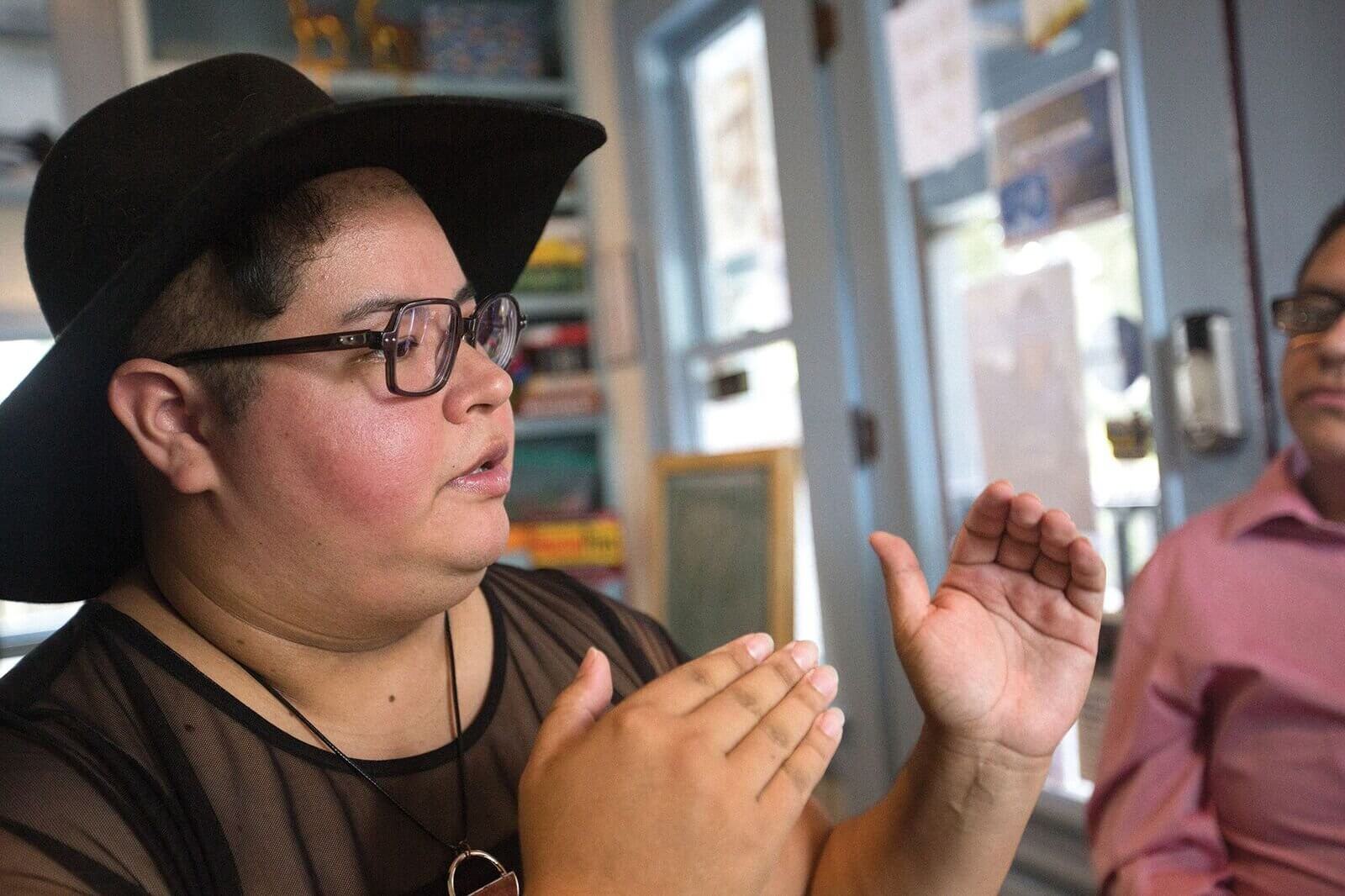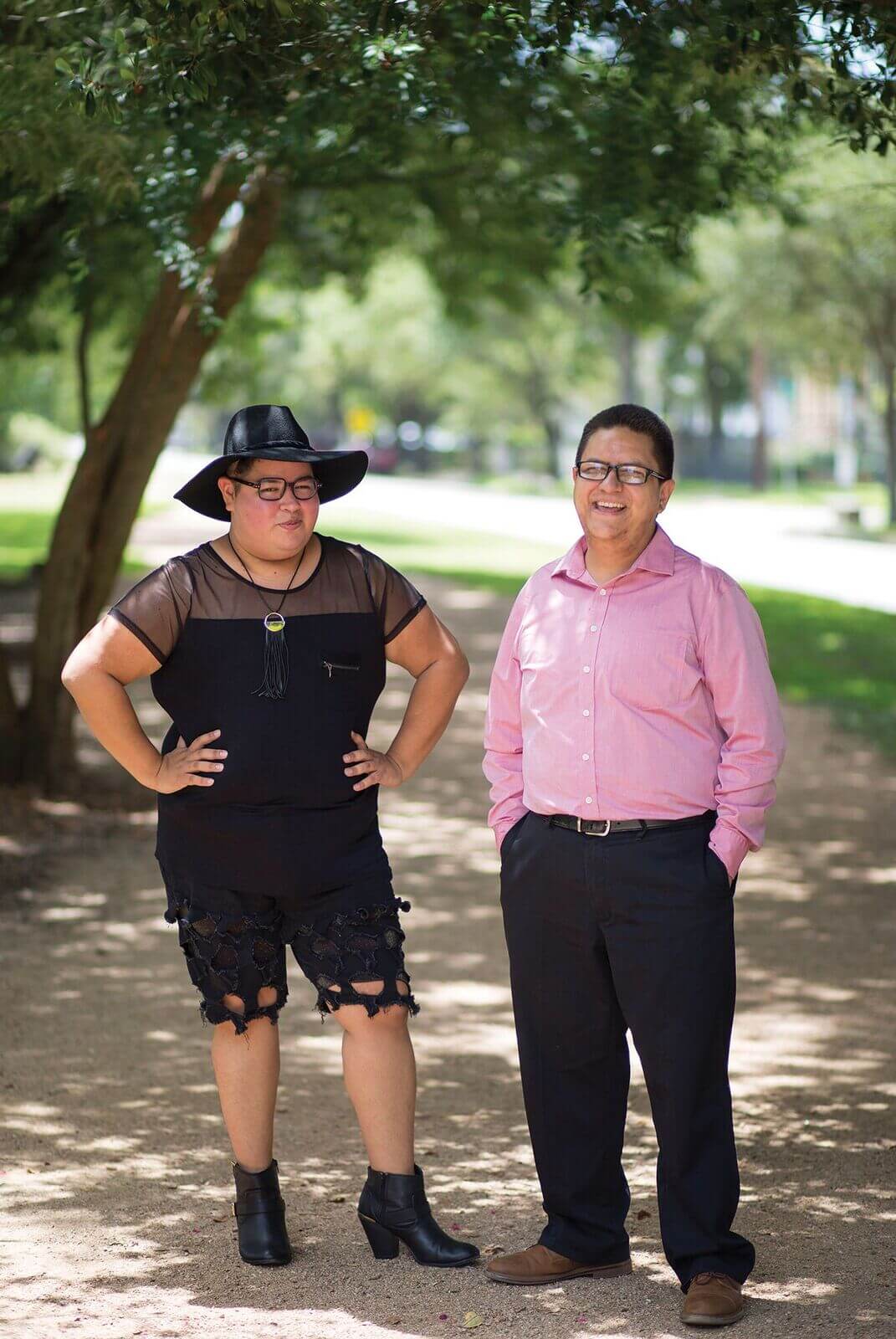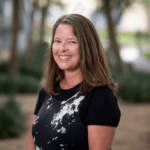Raising Awareness of Intersex Issues

Every Friday night, for years, Mo Cortez and Koomah attended the same youth group. As teenagers, they sat in a room together for hours, neither knowing they each harbored the same secret: they were born intersex.
“We both didn’t talk about it, because there was a lot of shame and stigma,” said Koomah, who goes by one name. “We sat next to each other for years feeling like the only person on the face of the planet.”
It wasn’t until 2012, about a decade after they had met, that they discovered a kinship they never knew existed. Koomah, an artist, had written a performance piece that was related to being intersex. Cortez heard of the performance through a friend, which led to the two reconnecting.

Koomah, left, who goes by one name, and Mo Cortez first met as teenagers, not knowing they were both intersex. They reconnected a decade later and founded the Houston Intersex Society.
“That day, we decided nobody else should ever feel like we had,” Koomah said. June 17, 2012, marked the founding of their organization, the Houston Intersex Society.
The term “intersex,” also known as “differences of sex development,” or DSD, refers to “congenital conditions in which development of chromosomal, gonadal or anatomic sex is atypical,” according to the American Medical Association (AMA). While DSD conditions are not common, they are also not particularly rare—some estimates indicate between 0.05 and 1.7 percent of the population are born with intersex traits, according to the Office of the United Nations High Commissioner for Human Rights (OHCHR). The upper limit of that range is similar to the number of people who are born with red hair.
For decades, intersex conditions were seen as issues that needed to be corrected as soon as possible—often via surgery on infants or young children. “It used to be believed that a lot of somebody’s gender was socially determined,” said Janet Malek, Ph.D., an associate professor in the Center for Medical Ethics and Health Policy at Baylor College of Medicine. “The practice was to make a decision as early as possible, and then raise the child with that gender the parents or doctors agreed was more appropriate, often depending on physical features.”
Cortez, 33, a contractor at a military vendor, recalled the first time he realized his body was different—when he woke up in the hospital at age 5, post-surgery.
“Medically I was considered ‘corrected,’ but that was the first time I had a vague inkling I was intersex,” he said. Born with ambiguous sexual organs, Cortez said doctors told his mother to raise him as a female. When he was 5 years old, his “mother was turned in to child welfare because someone thought she was raising a boy as a girl,” according to personal medical records provided by Cortez.
“They went ahead and performed normalization surgery” to make him appear more female, said Cortez, who identifies as male. “For the rest of my life, I will have to take synthetic hormones.”
Cortez’s experiences are not uncommon among intersex adults. But in recent years, many have been advocating for a change in the way the medical community approaches intersex conditions. A watershed moment, Koomah said, was a public demonstra-tion held by intersex organizations at a 1996 American Academy of Pediatrics conference in Boston.
“That was a springboard moment of this community coming together and not being afraid to speak out anymore,” Koomah said. That day—Oct. 26—has since been declared Intersex Awareness Day. Last year, Houston’s City Hall was illuminated in yellow and purple to mark the occasion. This year, the illumination will take place on Oct. 25.
Intersex individuals, along with the United Nations, human rights organizations and some medical professionals, have also been questioning the practice of performing medically unnecessary surgery on intersex infants or young children before they have the ability to understand and consent.
On 2016 Intersex Awareness Day, the U.S. Department of State released a statement saying, “Intersex persons routinely face forced medical surgeries that are conducted at a young age without free or informed consent. These interventions jeopardize their physical integrity and ability to live free.”
And more recently, in June 2017, three former surgeons general—M. Joycelyn Elders, M.D., David Satcher, M.D., and Richard Carmona, M.D.—released a document entitled “Re-Thinking Genital Surgeries on Intersex Infants.” They urge that “treatment should focus not on surgical intervention but on psychosocial educational support for the family or child … until children are old enough to voice their own view about whether to undergo the surgery.” The question of informed consent is a key ethical consideration when it comes to medically unnecessary surgery on children, Malek said.
“The idea here is that we should let the child be the one to make that decision. If the parents choose to have the surgery very early on, they take that choice away from the child,” Malek said. “Out of respect for the fact children will grow into adults who will need to make their own decisions, we want to offer them that choice.”
The AMA does not currently have a specific policy for treating intersex patients, however the AMA’s House of Delegates is expected to consider adopting an official policy at a future meeting. The organization does have established ethical opinions and policies that broadly address decisions for minors, including one that “encourages involving minor patients in decision making at a developmentally appropriate level.”
This past legislative session, Cortez and Koomah contributed to Texas Senate Bill 1342, which would have amended the Texas Family Code to prohibit “nonconsensual genital surgery” on intersex minors under state care. But the bill, introduced by Sen. Sylvia R. Garcia, D-Houston, died in the State Affairs Committee at the end of the session.
Koomah and Cortez both emphasized that the bill was focused on surgeries that are “medically unnecessary.”
“There are things that do need surgical intervention right away, and we are not trying to prevent those kinds of surgeries,” Koomah said. “But if it’s just cosmetic, it’s something that can safely be put off until someone is older and can make their own decision.”
As part of that decision-making process, Marni Axelrad, Ph.D., a child and adolescent psychologist at Texas Children’s Hospital, counsels intersex children, as well as their parents.
“I talk a lot about gender identity, which is in some ways easier when it’s an older child, because the gender identity is established,” Axelrad said. “With a baby, it’s tricky because we don’t know what a baby’s gender identity is going to be.” She added that typically children can reliably report their gender identity between ages two and four, “when it really becomes more established and clear.”
Additionally, Axelrad said, she discusses with parents the most devel-opmentally appropriate ways to talk to their children about being intersex. Part of that includes initiating conversations “from the moment your child can understand that this is their body, and the importance of being honest with them.”
“The ultimate treatment position for any child and any family is made on an individual basis, thinking about the overall wellbeing of the child,” Axelrad said. “Psychological wellbeing does play a role in that.”
Both Cortez and Koomah said their families did not have such open communication about being intersex, or provide much psychological support.
“It was always a big secret. Part of that is I don’t think they fully understood it either. And then with their own backgrounds and belief systems, they had their own perspective,” Koomah said. “I was never quite female enough for my parents, so there was this thought, ‘Well, if you’re not going to be a girl, you’re going to be a boy.’ That didn’t really work either so I’m kind of in this great in between space. This is what works and what makes me happy.”
Malek said society’s increased acceptance for ambiguity around gender, sex and sexual orientation may also be contributing to increased awareness and advocacy regarding intersex issues.
“People are more aware that it’s not necessarily black and white,” Malek said. “With increased understanding comes increased tolerance. Parents can say, ‘I’m OK with the idea that I’m not sure yet whether my child is a boy or a girl.’ Obviously some still have a very hard time with it, but we tend to be more accepting in today’s culture than it used to be.”
Acceptance, awareness, education—these are cornerstones of the advocacy work Cortez and Koomah are doing. The pair, who live together as roommates, talk to medical students and give lectures at universities about being intersex. They attend conferences and participate in lobbying. Their goal is to increase visibility of intersex people in society so no other young people have to grow up with the same feelings of isolation they both experienced.
“Our bodies are different,” Cortez said, “but embrace the diversity. Embrace the difference.”
“A lot of what is presented about our community is doom and gloom,” Koomah added. “We do have a lot of issues, but at the same time, there are a lot of happy, healthy, productive intersex people who are doing amaz-ing things. Our lives are not a tragedy. Whether a person has had surgery or hasn’t, there are folks that are very happy with their bodies.”

